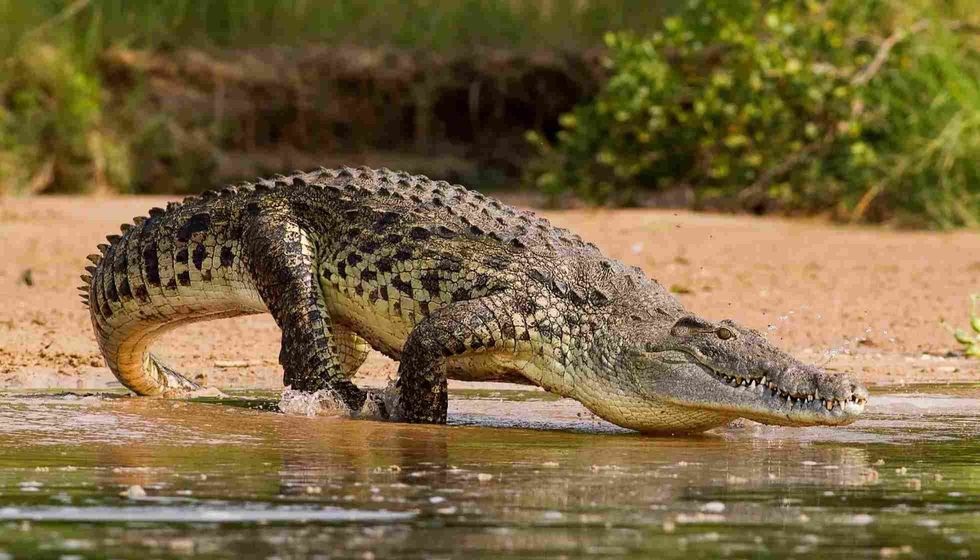The Nile crocodile is a Southern African crocodile. They are named after the Nile River, which runs through the African continent.
These crocodiles are larger than most crocodile species in Africa; they are second largest after the saltwater crocodiles. The Nile crocodile's bite strength of an adult is so large that it easily attacks and can easily cut through bones and flesh.
These African crocodiles can travel large distances in a single go. The discovery of a Nile crocodile in Florida was very shocking to the researchers as according to them the chances of a Nile crocodile coming to Florida were very slim but since the 1960s, various non-native crocodile species have been found in Florida.
The Nile crocodile is now found in most parts of the Nile river but somehow has not been able to penetrate the upper Nile lakes. Fish make for the primary diet of this animal.
Here are some interesting facts about the Nile crocodile for your perusal. Thereafter, do check our other articles on green anaconda facts and map turtle facts as well.
Nile Crocodile Interesting Facts
What type of animal is a Nile crocodile?
An African Nile crocodile is a crocodile. These freshwater crocodiles can be easily located in the rivers of dense forests. Also, they like to live in their groups and don’t prefer a solitary life.
What class of animal does a Nile crocodile belong to?
An African Nile crocodile belongs to the Reptilia class of animals.
How many Nile crocodiles are there in the world?
There are 50,000-70,000 Nile crocodiles in the world. Their population once was almost extinct. Their current population is not the best, and it is observed to be decreasing.
Where does a Nile crocodile live?
A Nile crocodile lives in wild areas like the wetlands and the savannahs. Numerous Nile crocodiles are found near the Nile river in Africa.
What is a Nile crocodile's habitat?
A Nile crocodile is a freshwater crocodile. Its habitat includes rivers, lakes, swamps, savannahs, and other wild areas.
These crocodiles do not live far away from a water source. They choose a spot where they will have maximum access to prey and water, and at the same time, a place to lay eggs. Unlike saltwater crocodiles, Nile crocodiles are very rarely spotted in salty waters.
Who do Nile crocodiles live with?
Nile crocodiles live and prey with crocodiles of their own and other species. They share common grounds with other wild animals as well.
How long does a Nile crocodile live?
The Nile crocodile lifespan ranges between 50-60 years. The lifespan of a Nile crocodile can be a bit longer in captivity. They have the same life span as humans, however, they are way more powerful than humans.
How do they reproduce?
The males of Nile crocodile species are known to be attracted to a female and catch her attention by displaying gestures. These gestures include splashing water, snouting, slapping their tail, and blowing water from their nostrils.
The females lay eggs in a shady area two months after mating. The female Nile crocodiles dig up a hole in the ground to lay eggs. After laying the eggs, they cover the eggs and the hole with mud or sand.
The female saltwater crocodile hardly leaves the site of eggs from their sight. The male also guards the site against other crocodiles or predators.
The eggs take three months to hatch. Just before hatching, the young crocodiles give out loud calls. That is how the female knows her eggs are about to hatch.
She digs up the eggs for hatching. After hatching, the female adult saltwater crocodile carries the young crocodiles to a nearby water source for feeding.
What is their conservation status?
The conservation status of Nile crocodiles is of Least Concern. Even though their population is not huge, Nile crocodiles are categorized under Least Concern because they are nowhere near extinction.
Nile Crocodile Fun Facts
What do Nile crocodiles look like?

A large Nile crocodile ranges from dark olive to brown in color in South Africa. It is a huge animal with four legs and a long, scaled tail. Their entire body is rough and scaled.
Their legs are short and their tails are very long. They attack their prey with their tail. Their snout is also long but not as long as the tail.
Like saltwater crocodiles, Nile crocodiles have a medium-width snout. Their snouts are thin and almost triangular in shape. Even though their legs are short, they have great speed and can attack their prey in no time.
How cute are they?
A Nile crocodile cannot exactly be called cute. It looks dangerous and fascinating. It has grace and a strong personality. They are very powerful. Some might find them gross too.
How do they communicate?
Nile crocodiles are very vocal animals. Their voice is very loud and easily scares humans and small animals. They hiss, gape, and use other vocal signals to communicate. Apart from the vocal signals, Nile crocodiles used gestures and body language to talk to each other. They splash, lunge, and bite to establish dominance and communication.
How big is a Nile crocodile?
The Nile crocodile's length ranges between 11.5-16.4 ft (350.5 - 499.8 cm). These creatures are huge and can be up to 10 times larger than an average-sized dog. Some Nile crocodiles grow longer than a giraffe’s height.
How fast can a Nile crocodile move?
A Nile crocodile can move as fast as 18.6-21.7 mph (29.9-34.9 kph). It may not be a fast speed but they are agile and that gives them the upper hand when hunting.
How much does a Nile crocodile weigh?
A Nile crocodile can weigh anywhere between 500-1650 lb (226.7-748.4 kg).
What are the male and female names of the species?
No specific names are assigned to the adult males and females of the Nile crocodile species. They are simply called Nile crocodiles.
What would you call a baby Nile crocodile?
A baby of the Nile crocodile species is called a hatchling
What do they eat?
Nile crocodiles are carnivorous predators. They eat and prey on fishes, reptiles, birds, and mammals. Their diet even includes humans if they get their hands on one. Many times, groups of Nile crocodiles are seen to travel long distances. These travels are usually for feasting.
Are they poisonous?
It is believed that the bile juice from the gall bladder of a Nile crocodile is very poisonous. It has the ability to kill humans very quickly.
Would they make a good pet?
Nile crocodiles would hardly make a good pet. They have a strictly carnivorous diet. They are predatory animals and will not think twice before attacking humans and preying on them. Many man-eater crocodiles of this species have been reported in the past. The Nile crocodile attack can be fatal to humans. That is why Nile crocodiles are called man-eaters.
Did you know...
Nile crocodiles living in the Nile river have not yet penetrated the Nile basin lakes.
Nile crocodiles in Kruger National Park are an average of 12 ft (365.7 cm) in length.
A young Nile crocodile baby grows 1 ft (30.48 cm) every year.
The largest Nile crocodile was named Lolong. It was 20 ft 3 in (617 cm) long.
Travel agencies are known to arrange tours especially for seeing Nile crocodiles.
Some Nile crocodiles are found to live in swamps in Florida.
Different types of Crocodile
The comparison of alligator vs crocodile gave the following inferences. A Nile crocodile has a narrow and triangular mouth, while an American alligator has a wider and rounder mouth.
While doing the Nile crocodile size comparison, it was found that the American alligators are much smaller in size as compared to Nile crocodiles. Nile crocodiles have a lesser number of babies as compared to the American alligator.
The comparison of the American crocodile vs the Nile crocodile told us that the head of an American Crocodile is similar to that of a Nile crocodile.
Nile crocodiles are more aggressive than American Crocodiles. While comparing the Nile crocodile vs the saltwater crocodile, observation was made that saltwater crocodiles are the largest while Nile crocodiles are the second largest.
Why are Nile crocodiles endangered?
Nile crocodiles have a current population of 50,000-70,000 individual crocodiles. The fact is that they are not technically an endangered species, but their population has decreased over the years.
Humans tend to hunt them for water supply and their skin. There was a time when Nile crocodiles were nearly extinct, but help was given to them by placing them under protection and encouraging the breeding of new young crocodiles.
Here at Kidadl, we have carefully created lots of interesting family-friendly animal facts for everyone to discover! Learn more about some other reptiles including Aldabra giant tortoise facts, or olive ridley sea turtle facts.
You can even occupy yourself at home by coloring in one of our free printable Nile crocodile coloring pages.










